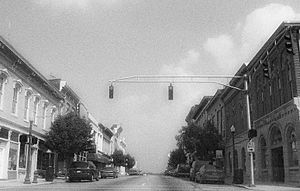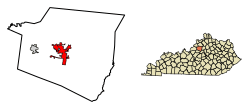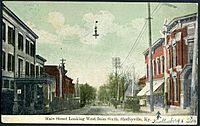Shelbyville, Kentucky facts for kids
Quick facts for kids
City of Shelbyville
|
|
|---|---|

Main Street
|
|
| Nickname(s):
"American Saddlebred Capital of the World"
|
|
| Motto(s):
"The Gateway to the Bluegrass"
|
|

Location of Shelbyville in Shelby County, Kentucky.
|
|
| Country | United States |
| State | Kentucky |
| County | Shelby |
| Established | 1792 |
| Incorporated | 1846 |
| Named for | Gov. Isaac Shelby |
| Government | |
| • Type | Mayor-council government |
| Area | |
| • Total | 9.13 sq mi (23.64 km2) |
| • Land | 8.96 sq mi (23.21 km2) |
| • Water | 0.17 sq mi (0.43 km2) |
| Elevation | 771 ft (235 m) |
| Population
(2020)
|
|
| • Total | 17,282 |
| • Estimate
(2022)
|
17,565 |
| • Density | 1,928.79/sq mi (744.69/km2) |
| Time zone | UTC-5 (Eastern (EST)) |
| • Summer (DST) | UTC-4 (EDT) |
| ZIP codes |
40065-40066
|
| Area code(s) | 502 |
| FIPS code | 21-70050 |
| GNIS feature ID | 2405455 |
Shelbyville is a city in Shelby County, Kentucky, United States. It is the county seat, meaning it's the main town where the county government is located. In 2020, about 17,282 people lived there. Shelbyville is often called the "American Saddlebred Capital of the World" because of its strong connection to these beautiful horses.
Contents
History of Shelbyville
Early Beginnings
Shelbyville was founded in October 1792. A local landowner, William Shannon, gave 50 acres of his land to create the town. He also gave one acre for public buildings. This helped Shelbyville become the main town for Shelby County. The town was built near Clear Creek and Mulberry Creek. It was also on a route between Louisville and Frankfort.
Early residents had to build a log cabin with a stone chimney. By 1795, there were 40 such cabins. By 1800, 262 people lived in Shelbyville. The town grew, and new areas were planned in the early 1800s.
Education was important from the start. The Shelbyville Academy opened in 1798. Over the years, it changed names and locations. Other schools for young women, like Science Hill Female Academy, also opened. These schools helped many students get ready for college.
In the 1830s, a road called the Louisville and Shelbyville Turnpike was finished. This road connected Shelbyville to Louisville. Later, a railroad was built nearby, which also helped the town grow.
During the Civil War
During the Civil War, Shelbyville saw some action. In August 1864, a group of Confederate fighters tried to take weapons from the Shelby County Courthouse. Local people fought them off. Some people were killed in the fight.
After this event, the town made all white men over 18 serve as police guards. They even built a small fort in front of the courthouse.
Later, in 1865, a group of local guards helped track down Confederate fighters in the area. They found and defeated a famous leader named William Clarke Quantrill. The town was very happy and celebrated their return. After the war ended, the fort was taken down.
Recent Times
After the Civil War, Shelbyville's economy grew. The town was known for farming products like corn, tobacco, and beef. In 1870, the Shelby Railroad Company connected the town to a larger rail line. This helped businesses thrive.
Downtown Shelbyville expanded, and many beautiful buildings were constructed. This was especially true after a big fire in 1909. The town also got public water, electricity, and libraries in the late 1800s.
In 1960, Interstate 64 was built just south of the city. This highway made it easier for industries to move to Shelbyville. Now, there are three industrial parks on the west side of the city. The population grew from 4,525 in 1960 to over 10,000 by 2000.
Geography and Climate
Shelbyville is located in the middle of Shelby County. It is on U.S. 60 and north of Interstate 64. The city covers about 7.6 square miles (19.7 square kilometers). Most of this area is land, with a small amount of water.
The weather in Shelbyville has hot, humid summers. Winters are usually mild to cool. This type of weather is called a humid subtropical climate.
Population Information
| Historical population | |||
|---|---|---|---|
| Census | Pop. | %± | |
| 1800 | 262 | — | |
| 1810 | 444 | 69.5% | |
| 1830 | 1,201 | — | |
| 1840 | 446 | −62.9% | |
| 1860 | 811 | — | |
| 1870 | 2,180 | 168.8% | |
| 1880 | 2,393 | 9.8% | |
| 1890 | 2,679 | 12.0% | |
| 1900 | 3,016 | 12.6% | |
| 1910 | 3,412 | 13.1% | |
| 1920 | 3,760 | 10.2% | |
| 1930 | 4,033 | 7.3% | |
| 1940 | 4,392 | 8.9% | |
| 1950 | 4,403 | 0.3% | |
| 1960 | 4,525 | 2.8% | |
| 1970 | 4,182 | −7.6% | |
| 1980 | 5,329 | 27.4% | |
| 1990 | 6,238 | 17.1% | |
| 2000 | 10,085 | 61.7% | |
| 2010 | 14,045 | 39.3% | |
| 2020 | 17,282 | 23.0% | |
| 2022 (est.) | 17,565 | 25.1% | |
| U.S. Decennial Census | |||
In 2000, there were 10,085 people living in Shelbyville. About 3,822 households were in the city. The population was made up of different groups. About 75% were White, and 16% were African American. About 9.5% of the population was Hispanic or Latino.
Many households had children under 18 living with them. The average household had about 2.5 people. The average family had about 3 people.
The median age in the city was 32 years old. This means half the people were younger than 32, and half were older. About 26% of the population was under 18.
Education in Shelbyville
Public schools in Shelbyville are managed by the Shelby County Public School District. This district runs Martha Layne Collins High School and Shelby County High School.
Shelbyville also has a lending library. It is called the Shelby County Public Library.
Arts and Culture
Shelbyville is famous for its connection to Saddlebred horses. It is known as the "Saddlebred Capital of the World."
The city hosts an annual Shelbyville Horse Show. Many famous people, like William Shatner, have visited this show. The annual Shelbyville Dogwood Festival is another popular event. It is an arts and crafts festival that brings in many visitors.
Shelbyville is also home to an independent record label called Somewherecold Records. In June 2021, Shelbyville held its first pride parade. It was organized by a local group called the Shelby County Pride Committee.
Economy
Shelbyville has two distilleries. These are places where alcoholic drinks like bourbon are made. Jeptha Creed Distillery opened in 2017. It makes bourbon, vodka, and moonshine. Bulleit is a larger distillery built by the company Diageo in 2018. It provides jobs for many people.
Notable People from Shelbyville
Many interesting people have connections to Shelbyville:
- Major General J. Franklin Bell received a Medal of Honor.
- Martha Layne Collins was the first woman to be governor of Kentucky.
- Jack Harlow, a famous rapper, lived in the Shelbyville area when he was young.
- Colonel Sanders, who started Kentucky Fried Chicken, lived in Shelbyville for many years.
- Augustus Owsley Stanley served as a U.S. senator and governor.
- Lee Tinsley played in Major League Baseball.
See also
 In Spanish: Shelbyville (Kentucky) para niños
In Spanish: Shelbyville (Kentucky) para niños


